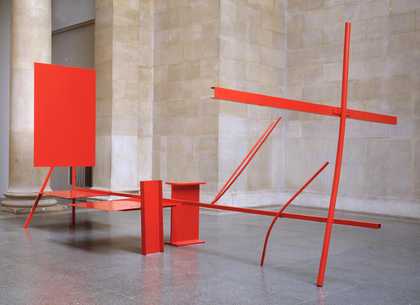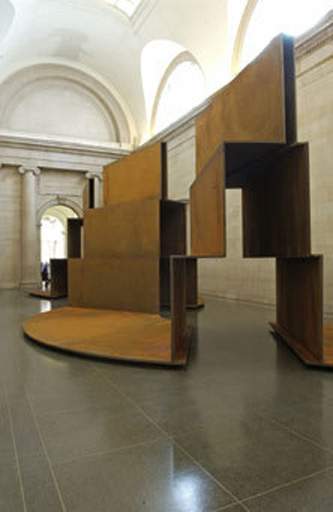Michael Fried
When did you first become interested in Anthony Caro’s work, and what did it mean to you then?
Charles Ray
In 1971 at the University of Iowa. I enrolled in a sculpture class that was taught by Roland Brenner, who had been a student of Caro at St Martins in the early 1960s. Brenner was very strict in his approach to teaching the sculpture studio class. We learned to weld and were taken to the scrapyard to buy metal. We drew or sketched our ideas directly with the material at hand. He walked around and encouraged our configurations to move in certain directions. We looked at a lot of slides of Caro’s work, as well as other contemporary sculptors. The crit phase of the studio was constant. A lot of the students felt the class was too dictatorial. For me, it was liberating. As a young student I was unaware of the historical context, but I found this phase of Constructivism a wonderful time and place to enter sculpture. I really didn’t need to understand what I was doing. Caro’s work was like a template; I saw it as almost platonic. The formal rules as taught by Brenner were a kind of nourishment for me. The actual working in the studio was, in a sense, the expression. I was taught that the finished sculpture was maybe the end of a paragraph. Once a sculpture was completed it was critiqued and put back on to the scrap pile. This way of working taught me to think sculpturally rather than to think about sculpture. At this time in my life the historical context of high Modernism was really beyond my grasp. I saw Caro as super-contemporary. His work was, and is, so alive. It bridges a gap between the inside and outside of my mind.
Michael Fried
What about Caro’s Early One Morning from 1962? It seems to have been a work you were particularly interested in?
Charles Ray
I’m still amazed by the experience of viewing Early One Morning. It is sculptural disjunction compressing and expanding space in such a hallucinogenic way. The sculpture seems to be an armature that space clings to like clay. In 1962 The Beatles were singing ‘I want to hold your hand’. The hallucinogenic scene didn’t explode on to pop culture until five or six years later. Not that this sculpture was prophetic of the coming youth culture involvement with drug experiences, but it was so born in its time. It is so alive in its making that it seems unlikely ever to die. Early One Morning is a work that I gauge myself by. I never re-created it, but at one time I wanted to use it as an image on an announcement poster for a show I was having at the ICA in London. There’s a wonderful painting by Edward Hopper with a young woman sitting nude on an unmade bed in a hotel room. I wanted to have a young woman sitting nude on the I-beam of Early One Morning. Caro agreed in principle. The sculpture is very fragile. The aluminium tubes and plate are so extended structurally that it’s almost magic that the sculpture stands at all. Caro did not want a public image of it that would suggest it might be strong enough to be sat on. He very generously gave me permission to photograph a model standing near it, but I declined, as that would not work for what I was attempting to do. I was trying to make a picture. I was thinking about time and its necessity for contemplation. Around the same time I was attempting to return to abstract sculpture. I was struggling. Every move I made bumped into genre problems. I had a photo of Early One Morning on my bookcase. A gallon apple cider jug somehow was turned on its side directly in front of the photograph. It instantly hit me that here was a possible solution to my sculpture problem. I could take the genre of a ship in a bottle and use its space to create a sculpture within – a short cut out of my problem? I began trying to assemble abstract sculptures in bottles. They never did what I wanted them to do. I learned that a ship in a bottle is not sculptural. You never need to walk around the back, or see it from the side. The bottle is a frame and you view the ship and the feat of its construction in a pictorial way. I did remain very interested in the space inside a bottle and eventually made Puzzle Bottle in 1995. There is abstractness to the space of Puzzle Bottle. The figure is really the armature to build both the space and the bottle that contains it. After making Puzzle Bottle I started working on a sculpture for Documenta and the sculpture show in Münster in Germany. I spent a year learning how to make my own clothes and shoes. My contribution was going to be a short 35mm film entitled Self-portrait with home-made clothes. It was to play as a trailer in the local movie theatres. There was a similarity to Puzzle Bottle with the utilisation of space associated with media and genre. I didn’t finish the clothes in time to make the film. A few years later I had to come up with an image for the catalogue of another show. So that’s me in my home-made clothes digitally placed in front of Early One Morning!

Sir Anthony Caro
Early One Morning (1962)
Tate
Michael Fried
What lessons do you feel Caro’s art holds today for young aspiring sculptors or, for that matter, artists in other media?
Charles Ray
That’s a hard question as there are many trajectories in and out of Caro’s work. But I think his shift from figuration to abstraction in 1960 is an inspiring moment. It’s as interesting to think about what he brought with him as what he left behind. It seems that his art came up against a limitation, which he was able to convert into a boundary or a border that could be stepped across. How open that moment was.
Michael Fried
Can I just press you a bit more about the possible significance of this for the present moment?
Charles Ray
I would be hesitant to answer that question, as inspiration is such a fluid process. Recently, I went to the university and asked a young art student if there was anything he might learn from Caro’s work. He didn’t know. So I asked him what sculpture shows he had seen recently. He had seen Robert Smithson at the Museum of Contemporary Art in Los Angeles. He seemed to like it. I went on with my questions even though Smithson didn’t like Caro much at all. I asked this student what he thought could have happened between Smithson’s work and Caro’s. He said: ‘Well, I don’t know, maybe Postmodernism.’ I went back to thinking about Caro’s shift from figurative work to abstract sculpture. If I could share with a young artist any aspect of Caro, it would be his openness to move from the 1950s into the 1960s. He took a small closed gesture embodied in his figuration and he made it open and expansive in his abstract art. To accomplish this he abandoned one sculptural genre and greatly extended another. There are lots of lessons to be learned from Caro’s sculptures: how they sit on the floor; their extension into space; the relationship of parts rather than an overall shape or profile; the emphasis on juncture. What’s harder, if not impossible, to grasp is how his work changed our orientation to the art itself.

